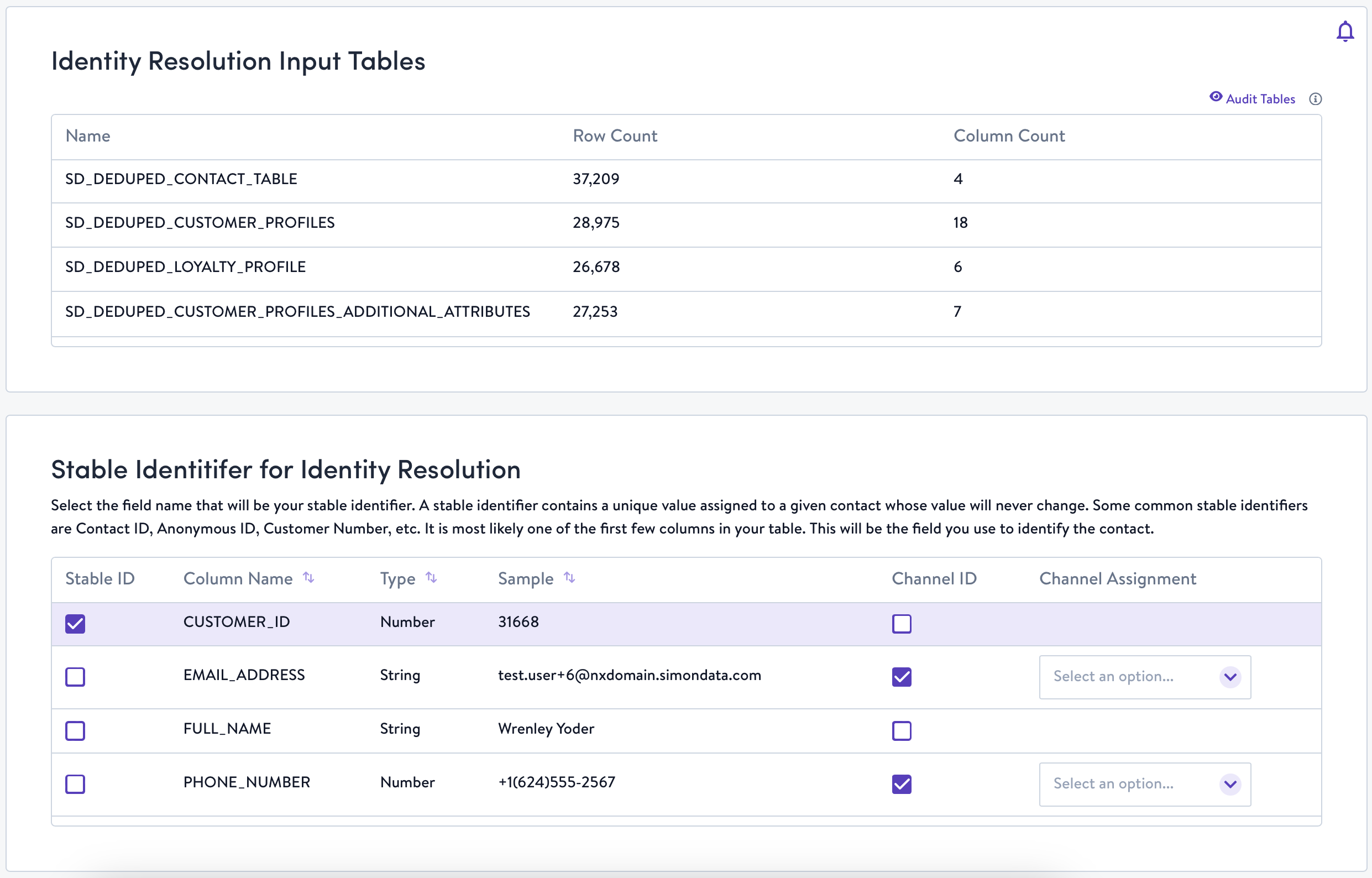Simon Resolve
Simon Resolve is currently an Alpha feature.Please reach out to your account manager to be added to the waitlist!
Overview
Simon Resolve is Simon’s in-CDW identity resolution offering, in addition to support and guidance for handling the integration of the resulting identity model into more general contact data modeling and into downstream marketing use cases. That means it goes beyond simply mapping identifiers and managing our simon_id and into survivorship, identity stitching, QA, and safely making and deploying changes to the core identity model over time.

Simon Resolve is preceded upstream by Simon Dedupe, Simon's entity resolution offering, and is followed downstream by Simon's composable CDP application. It can be further enhanced via Simon’s Managed Identity Services.
What is the difference between Entity and Identity Resolution?
Identity resolution and entity resolution are related concepts but they are used in different contexts and have distinct focuses. Here are the key differences between them:
Identity Resolution
Identity resolution is the process of accurately connecting disparate pieces of information across multiple channels and touchpoints to create a unified, cohesive view of individual contacts. This involves linking various data fragments — such as email addresses, phone numbers, and device IDs — to a single contact profile.
- Focus: Primarily deals with resolving individual identities.
- Application: Commonly used in marketing, customer relationship management (CRM), and personalization.
- Goal: To create a single, unified profile of a person by linking various data points (like email addresses, phone numbers, social media profiles, etc.) that belong to the same individual.
- Typical Data: Includes personal information such as names, contact information, purchase history, and online behavior.
- Purpose: To enhance customer experiences, personalize marketing efforts, and ensure consistent communication across different channels.
Entity Resolution
- Focus: Deals with resolving entities, which can be individuals, organizations, products, or any definable object.
- Application: Used in a broader range of fields including data integration, data quality management, knowledge graphs, and databases.
- Goal: To identify and merge records that refer to the same entity across different data sources.
- Typical Data: Includes diverse datasets such as business records, financial transactions, scientific data, etc.
- Purpose: To ensure data accuracy, eliminate duplicates, and integrate information from multiple sources for comprehensive data analysis and reporting.
Why is Identity Resolution Important?
Identity resolution is foundational for businesses looking to deliver personalized, consistent, and impactful marketing. It unifies fragmented data, eliminates duplication, and enables accurate customer targeting, ensuring that your marketing efforts are data-driven and customer-centric.
- Personalized Marketing: With a comprehensive view of the contact, marketers can tailor messages and offers to individual preferences and behaviors, leading to higher engagement and conversion rates.
- Consistent Customer Experience: Ensuring consistent and relevant interactions across all channels enhances customer satisfaction and loyalty.
- Data-Driven Decision Making: A unified contact profile provides accurate insights for strategic planning and campaign optimization.
- Regulatory Compliance: Proper identity resolution helps maintain data integrity and ensures compliance with data privacy regulations.
Key Components of Identity Resolution
By understanding and implementing these key components, businesses can create accurate, unified customer profiles that drive better marketing decisions and personalized customer experiences. Simon Resolve leverages these components to help businesses manage and unify their customer data with precision and scalability.
- Data Collection: Gather data from various sources such as CRM systems, transactional databases, social media platforms, and third-party data providers. See Data Routing.
- Data Matching: Use deterministic (exact match) methods when accuracy counts, such as when building marketable contacts which you will directly address via personalized messages. Use probabilistic (pattern matching) methods when error can be tolerated, such as in analytical applications or when performing deduplication within a single dataset prior to constructing your downstream golden record.
- Profile Unification: Consolidate matched data into single, comprehensive contact profiles.
- Survivorship Logic: Survivorship rules determine which data points to retain when merging records. For example, the most recent address or the most frequently used email address might be chosen as the “survivor” when conflicting data is found.
- Identity Enrichment: Enhance profiles with additional data attributes for deeper insights and more personalized interactions.
- Privacy and Security: Implement robust security measures to protect customer data and ensure compliance with privacy regulations.
Best Practices for Identity Resolution
By adhering to these best practices, businesses can build an effective identity resolution strategy that produces accurate, unified customer profiles, supporting personalized marketing and better customer experiences. Simon Data’s identity resolution tools are designed to help businesses implement these best practices with a scalable, user-friendly platform.
- Start with Clean Data: Ensure the accuracy and completeness of your data before beginning the resolution process.
- Use Advanced Matching Algorithms: Employ both deterministic and probabilistic matching to improve accuracy.
- Prioritize Data Privacy: Implement stringent security measures and comply with regulations such as GDPR and CCPA.
- Regularly Update Profiles: Continuously update and enrich contact profiles to maintain accuracy over time.
- Leverage Technology: Utilize entity resolution platforms and tools that incorporate machine learning and artificial intelligence for enhanced performance.
- Cross-Functional Collaboration: Work closely with IT, data science, and compliance teams to ensure a holistic approach to identity resolution.
- Measure and Optimize: Regularly assess the effectiveness of your identity resolution process and make necessary adjustments.
Simon's Take
Effective identity resolution and modeling are critical for modern marketing success. By following best practices in data collection, cleansing, matching, and profile unification, marketers can create accurate and comprehensive contact profiles.
Simon offers comprehensive services in and around its own suite of product offerings in this area which can extend from getting your contact profiles ready for your marketing team to more broadly modeling your data for use across your entire organization. While Simon’s focus is upon identity resolution, we’re happy to guide you through your entire data centralization and modeling effort, and offer a range of tools like Simon Dedupeand services like Managed Identity Services to assist your efforts.
Updated 6 months ago
